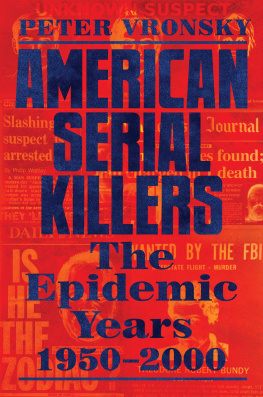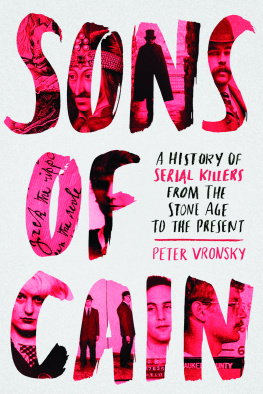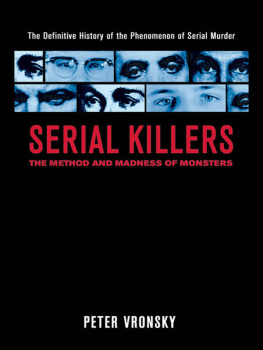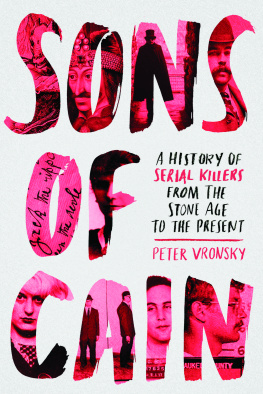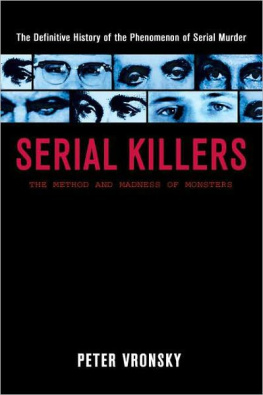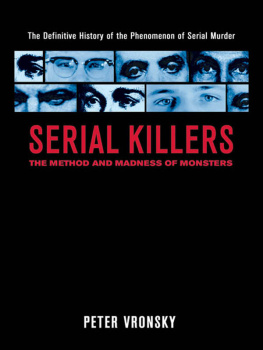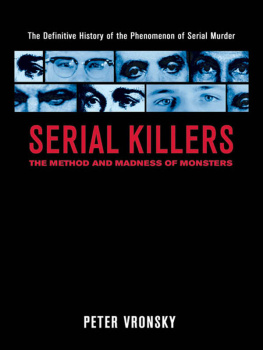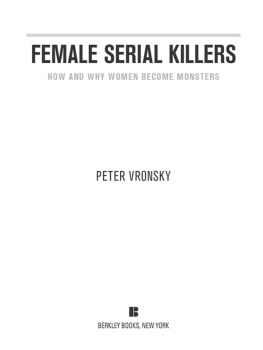Peter Vronsky - American Serial Killers: The Epidemic Years 1950-2000
Here you can read online Peter Vronsky - American Serial Killers: The Epidemic Years 1950-2000 full text of the book (entire story) in english for free. Download pdf and epub, get meaning, cover and reviews about this ebook. year: 2021, publisher: Penguin Publishing Group, genre: Detective and thriller. Description of the work, (preface) as well as reviews are available. Best literature library LitArk.com created for fans of good reading and offers a wide selection of genres:
Romance novel
Science fiction
Adventure
Detective
Science
History
Home and family
Prose
Art
Politics
Computer
Non-fiction
Religion
Business
Children
Humor
Choose a favorite category and find really read worthwhile books. Enjoy immersion in the world of imagination, feel the emotions of the characters or learn something new for yourself, make an fascinating discovery.
- Book:American Serial Killers: The Epidemic Years 1950-2000
- Author:
- Publisher:Penguin Publishing Group
- Genre:
- Year:2021
- Rating:5 / 5
- Favourites:Add to favourites
- Your mark:
- 100
- 1
- 2
- 3
- 4
- 5
American Serial Killers: The Epidemic Years 1950-2000: summary, description and annotation
We offer to read an annotation, description, summary or preface (depends on what the author of the book "American Serial Killers: The Epidemic Years 1950-2000" wrote himself). If you haven't found the necessary information about the book — write in the comments, we will try to find it.
American Serial Killers: The Epidemic Years 1950-2000 — read online for free the complete book (whole text) full work
Below is the text of the book, divided by pages. System saving the place of the last page read, allows you to conveniently read the book "American Serial Killers: The Epidemic Years 1950-2000" online for free, without having to search again every time where you left off. Put a bookmark, and you can go to the page where you finished reading at any time.
Font size:
Interval:
Bookmark:

Serial Killers
Female Serial Killers
Sons of Cain
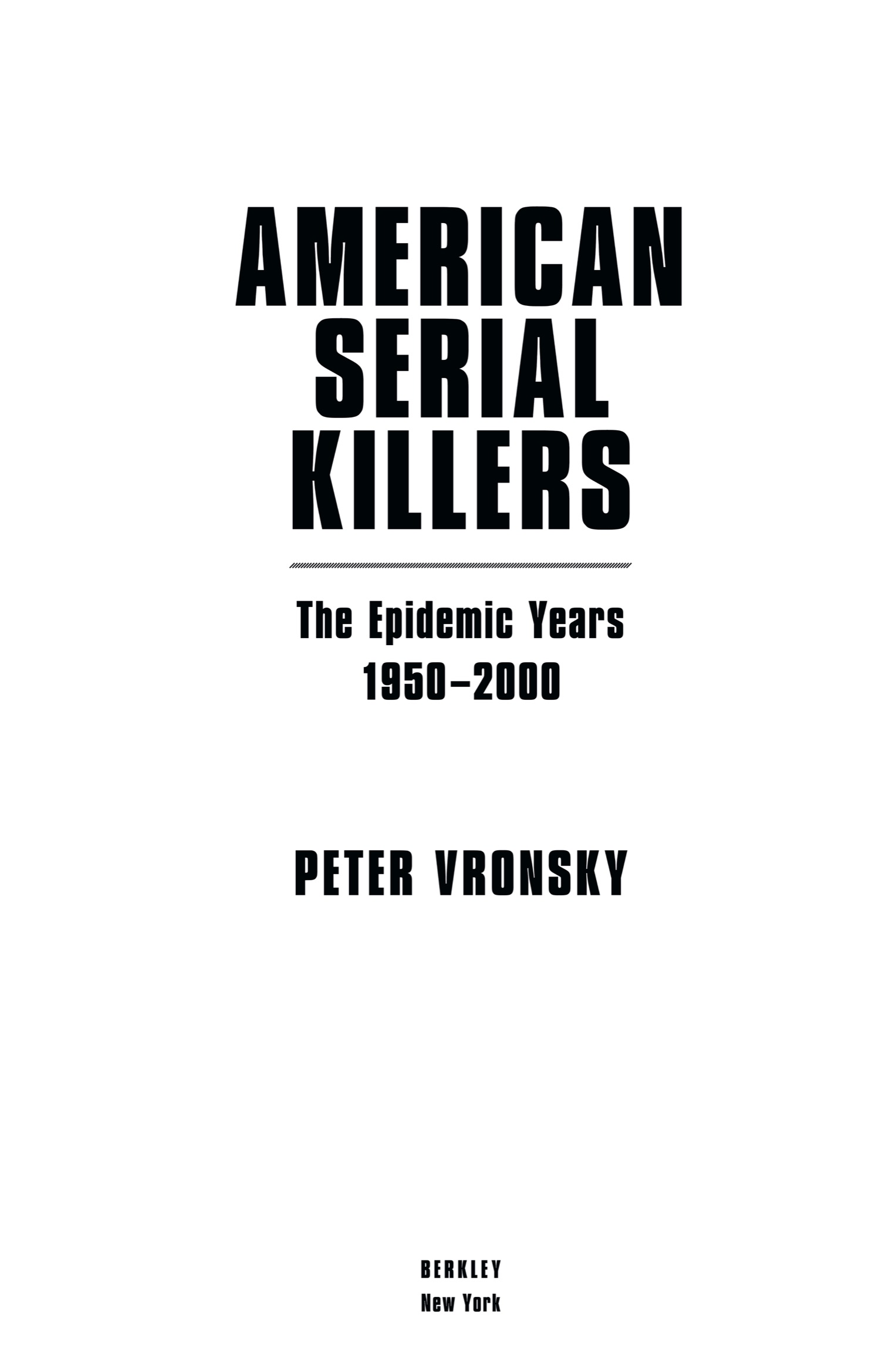
BERKLEY
An imprint of Penguin Random House LLC
penguinrandomhouse.com

Copyright 2021 by Peter Vronsky
Penguin Random House supports copyright. Copyright fuels creativity, encourages diverse voices, promotes free speech, and creates a vibrant culture. Thank you for buying an authorized edition of this book and for complying with copyright laws by not reproducing, scanning, or distributing any part of it in any form without permission. You are supporting writers and allowing Penguin Random House to continue to publish books for every reader.
BERKLEY and the BERKLEY & B colophon are registered trademarks of Penguin Random House LLC.
Library of Congress Cataloging-in-Publication Data
Names: Vronsky, Peter, author.
Title: American serial killers: the epidemic years 19502000 / Peter Vronsky.
Description: New York: Berkley, [2020]
Identifiers: LCCN 2020022004 (print) | LCCN 2020022005 (ebook) | ISBN 9780593198810 (hardcover) | ISBN 9780593198827 (ebook)
Subjects: LCSH: Serial murderUnited StatesHistory20th century. |
Serial murderersUnited StatesHistory20th century.
Classification: LCC HV6515 .V75 2004 (print) | LCC HV6515 (ebook) | DDC 364.152/32092273dc23
LC record available at https://lccn.loc.gov/2020022004
LC ebook record available at https://lccn.loc.gov/2020022005
Cover images: Top: Three sketches of the Golden State Killer, Wikipedia. Middle left: Robin Gecht article from Chicago Tribune, 1982 Chicago Tribune. All rights reserved. Used under license. Middle right: Kendall Francois article, from Poughkeepsie Journal, Gannett-Community Publishing. All rights reserved. Used under license. Bottom left: Zodiac Killer article, New York Daily News, 1990, Getty Images; Wanted sign of Ted Bundy, Getty Images. Back jacket images: The Cannibal news article courtesy Mirrorpix / Reach Licensing
Cover design by Emily Osborne
While the author has made every effort to provide accurate telephone numbers, Internet addresses and other contact information at the time of publication, neither the publisher nor the author assumes any responsibility for errors, or for changes that occur after publication. Further, publisher does not have any control over and does not assume any responsibility for author or third-party Web sites or their content.
pid_prh_5.6.1_c0_r0
For my beautiful wife, Anna Zinato, for all the years of her love and coffee
Cops can go for days, weeks and sometimes even years working routine shifts in which nothing extraordinary happens. They work a grind of calls to domestic disputes, medical distress, unruly customers, parking complaints and petty burglaries. A few go their entire career never once chasing a fleeing suspect, kicking in a door or unholstering their weapon. But all that can change in an instant.
On the evening of July 22, 1991, Milwaukee police officers Robert Rauth and Rolf Mueller were coming to the end of one of those routine shifts. They were assigned to District 3 in the Avenues West, a neighborhood that had seen better days. The Pabst beer family mansion stood there as did the campus of Marquette University and the Milwaukee High School of the Arts. But some parts of the neighborhood were rough and troubled, especially around the blocks at North 25th Street where the elegant old Victorian houses had been converted to rooming houses or torn down to make way for anonymous two- and three-story apartment buildings. The area was predominately populated by poor minorities, especially African Americans and recently arrived Southeast Asians.
It was 11:30 p.m., and it had been a quiet evening. Rauth and Mueller were hoping that nothing would come up in the next thirty minutes to delay them from ending their shift at midnight and going home. But just as they turned onto 25th Street from Kilbourn Avenue, the headlights of their patrol car came upon a shirtless black man running toward them. He had a pair of handcuffs dangling from his left wrist, and his face was contorted in panic and fear.
Rauth and Mueller had no idea what they had just driven into as they exited their vehicle to calm the hysterical man down. Thirty-two-year-old Tracy Edwards told the officers some freak had handcuffed him and begged them to get the handcuffs off his wrist. Rauth tried using his handcuff key, but it did not fit the brand of cuffs around Edwardss wrist. Had they been able to remove the handcuffs in the street, perhaps that would have been the end of it, and we would not have heard anything more of this story, at least not that July.
Edwards told them that he had been forcibly restrained for several hours in the Oxford Apartments just up the street. The officers accompanied Edwards to a shabby three-story apartment building at 924 North 25th Street. Their plan was to get the key, remove the handcuffs and hopefully clear the matter up quickly without having to arrest anyone, transport them and do a whole bunch of paperwork till God knows when.
Edwards led Rauth and Mueller to the door of apartment 213. The first thing they noted was that it had its own electronic alarm system and high-grade armored locks, unusual for a low-income apartment building in that neighborhood. Knocking on the door, they noticed a second thing: a distinct odor of death and decay wafting from the other side, a smell most cops are familiar with and never forget once they have experienced it.
The door was opened by a tall, slightly disheveled white male in his early thirties. He identified himself as Jeffrey Dahmer and showed them his employee identification card from the Ambrosia Chocolate factory, where he said he worked as a mixer. He was calm and polite and invited the officers and Edwards to step into his apartment.
Upon entering the small one-bedroom apartment, Rauth and Mueller almost gagged on the thick smell of human decay mixed with the perfumed scent of room deodorant and disinfectant.
At first glance, the apartment appeared to be completely normal. It was relatively well furnished with a couch and armchair, carpeting, floor and table lamps, cared-for plants and a large lit aquarium on a black table, its electric filter quietly humming and gurgling as fish lazily circled behind its glass. Thick blue curtains hung on the windows. The white walls were decorated with framed abstract posters and gay erotica, which by the 1990s wouldnt even raise a cops eyebrow.
Immediately to the left of the front door was the kitchen area with a sink, counter, stove and fridge. A small upright floor freezer stood next to a kitchen table cluttered with tools and beer cans. The apartment was moderately litteredlike after a small partywith empty beer cans, tissue boxes and spray cans of air freshener. There were several small plastic chemical containers and a stack of bright red boxes of Soilax, a floor and wall cleaner sold in hardware stores. The only really unusual thing about the apartmentother than the smellwas a big surveillance camera mounted high in a corner of the room.
Dahmer readily admitted that he had handcuffed Edwards but offered no explanation or showed any anxiety. His attitude was I do this all the time. So what?
Font size:
Interval:
Bookmark:
Similar books «American Serial Killers: The Epidemic Years 1950-2000»
Look at similar books to American Serial Killers: The Epidemic Years 1950-2000. We have selected literature similar in name and meaning in the hope of providing readers with more options to find new, interesting, not yet read works.
Discussion, reviews of the book American Serial Killers: The Epidemic Years 1950-2000 and just readers' own opinions. Leave your comments, write what you think about the work, its meaning or the main characters. Specify what exactly you liked and what you didn't like, and why you think so.

